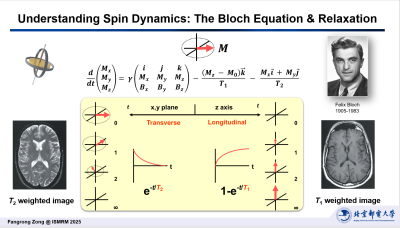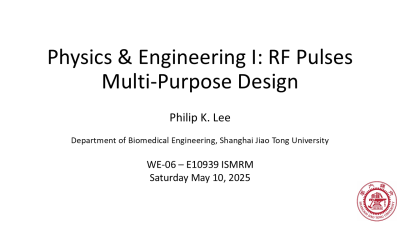Weekend Course
The Best of Two Worlds: Physics & Engineering I: Basics
ISMRM & ISMRT Annual Meeting & Exhibition • 10-15 May 2025 • Honolulu, Hawai'i

| 08:00 |
From Spin to Classical Description
Yang Gao, Xiaotong Zhang
Impact: This session explores the fundamentals of NMR,
spin excitation, and reception, introducing B1+ and B1-
fields. We discuss the transition from quasi-static to wave
propagation, highlighting near-field vs. far-field effects
in clinical and ultra-high-field MRI.
|
|
| 08:25 |
 |
Understanding Spin Dynamics: The Bloch Equation & Relaxation
Fangrong Zong
Impact: The Bloch equation governs MRI magnetization
dynamics via precession and relaxation (T1, T2). These
relaxation phenomena shape contrast in MR images. Advanced
extensions like the Bloch-Torrey equation and
multi-component relaxation push research frontiers.
|
| 08:50 |
The Many Sources of MR Contrast: T1, T2, T2*
Rita Schmidt
|
|
| 09:15 |
Magnet Design & Shims: General
Jason Stockmann
Impact: We discuss the design and optimization of
permanent and superconducting magnets for human MRI. We
then consider strategies for "shimming" the empty bore to
achieve a target homogeneity. Last, we review methods for
shimming the human body when tissues magnetize inside the
main magnetic field.
|
|
| 09:40 |
Break & Meet the Teachers |
|
| 10:05 |
Magnet Design Across Field Strengths
Sergei Obruchkov
Impact: This talk will explore magnet design across
field strengths, from Earth's field to advanced
superconductors. Examine pros, cons, and challenges of
electromagnets, permanent magnets, cryogen-free, and
conductively cooled designs, highlighting practical
applications and innovations.
|
|
| 10:30 |
 |
RF Pulses: Multi-Purpose Design (Spatially / Spectrally
Selective, Adiabatic, etc.)
Philip Lee
Impact: RF pulses are used in all MRI acquisitions, and
are thus an integral part of operating and designing MR
systems. This educational session will introduce approaches
used to design RF pulses, as well as the many applications
of RF pulses.
|
| 10:55 |
RF Coil Design: Basics to More Advanced
Roberta Frass-Kriegl
Impact: Key aspects of Radiofrequency (RF) coil
development across various magnetic field strengths are
highlighted, including impact on SNR and data quality, as
well as usability and patient comfort considerations.
|
|
| 11:20 | Panel Discussion and Q&A |
The International Society for Magnetic Resonance in Medicine is accredited by the Accreditation Council for Continuing Medical Education to provide continuing medical education for physicians.